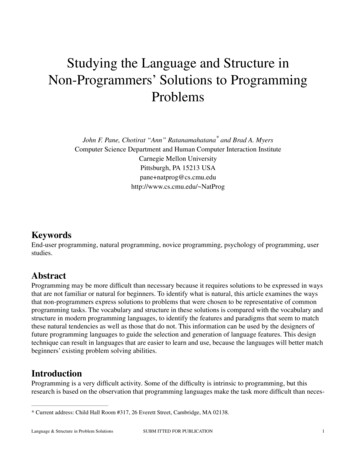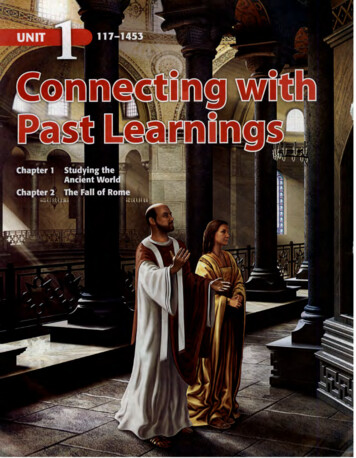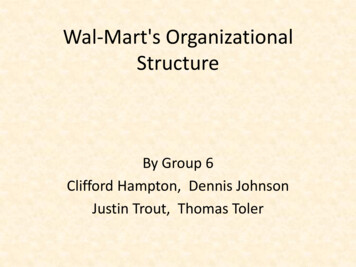
Transcription
Studying the Language and Structure inNon-Programmers’ Solutions to ProgrammingProblemsJohn F. Pane, Chotirat “Ann” Ratanamahatana* and Brad A. MyersComputer Science Department and Human Computer Interaction InstituteCarnegie Mellon UniversityPittsburgh, PA 15213 USApane natprog@cs.cmu.eduhttp://www.cs.cmu.edu/ NatProgKeywordsEnd-user programming, natural programming, novice programming, psychology of programming, userstudies.AbstractProgramming may be more difficult than necessary because it requires solutions to be expressed in waysthat are not familiar or natural for beginners. To identify what is natural, this article examines the waysthat non-programmers express solutions to problems that were chosen to be representative of commonprogramming tasks. The vocabulary and structure in these solutions is compared with the vocabulary andstructure in modern programming languages, to identify the features and paradigms that seem to matchthese natural tendencies as well as those that do not. This information can be used by the designers offuture programming languages to guide the selection and generation of language features. This designtechnique can result in languages that are easier to learn and use, because the languages will better matchbeginners’ existing problem solving abilities.IntroductionProgramming is a very difficult activity. Some of the difficulty is intrinsic to programming, but thisresearch is based on the observation that programming languages make the task more difficult than neces* Current address: Child Hall Room #317, 26 Everett Street, Cambridge, MA 02138.Language & Structure in Problem SolutionsSUBM ITTED FOR PUBLICATION1
sary because they have been designed without careful attention to human-computer interaction issues(Newell & Card, 1985). In particular, programmers are required to think about algorithms and data inways that are very different than the ways they already think about them in other contexts. For example, atypical C program to compute the sum of a list of numbers includes three kinds of parentheses and threekinds of assignment operators in five lines of code; in contrast, this can be done in a spreadsheet with asingle line of code using the sum operator (Green & Petre, 1996). The mismatch between the way programmers think about a solution and the way it must be expressed in the programming language makes itmore difficult not only for beginners to learn how to program, but also for people to carry out their programming tasks even after they become more experienced.The Natural Programming Project seeks to influence future programming languages by collecting ahuman-centered body of facts that can be used to guide design decisions (Myers, 1998). This will allowthe language designer to be more aware of the areas of potential difficulty, as well as suggest alternateapproaches that more closely match the ways that people think. This article describes a pair of new studies that examine the language and structure of problem solutions written by non-programmers, and contrasts these findings with the requirements imposed by popular modern programming languages.The first study focuses on children because they are the audience for a new programming language theauthors are designing. In addition, children are less likely to be programmers, so their responses shouldreveal problem solving techniques that have not been influenced by programming experience. The exercises in this study are drawn from the domain of computer games and animated stories, because childrenare often interested in building these kinds of programs. The second study then examines how the resultsof the first study generalize to a broader audience and a different domain.Related WorkThere has been a wealth of relevant research in the fields of Psychology of Programming and EmpiricalStudies of Programmers. In these fields, programming is often defined as a process of transforming amental plan that is in familiar terms into one that is compatible with the computer (e.g. Lewis & Olson,1987). Among others, Hoc & Nguyen-Xuan (1990) have shown that many bugs and difficulties arisebecause the distance between these is too large. This concept is called closeness of mapping by Green &Petre (1996, p. 146): “The closer the programming world is to the problem world, the easier the problemsolving ought to be. Conventional textual languages are a long way from that goal.” In that article theyprovide an extensive set of cognitive dimensions, which can be used to guide and evaluate languagedesigns. More concretely, Soloway, Bonar & Erlich (1989) found that the looping control structures provided by modern languages do not match the natural strategies that most people bring to the programming task. Furthermore, when novices are stumped they try to transfer their knowledge of naturallanguage to the programming task. This often results in errors because the programming language definesthese constructs in an incompatible way (Bonar & Soloway, 1989). For example, then is interpreted asafterwards instead of in these conditions. Many similar findings are summarized in an earlier report (Pane& Myers, 1996). While these studies identify many of the problems with existing languages, they do notprescribe solutions. The goal of the current work is to discover alternatives that can avoid or overcomethese problems.Striving for naturalness does not necessarily imply that the programming language should use naturallanguage. Programming languages that have adopted natural-language-like syntaxes, such as Cobol(Sammet, 1981) and HyperTalk (Goodman, 1987), still have many of the problems that are listed above,as well as other usability problems. For example, Thimbleby, Cockburn & Jones (1992) list many waysthat HyperTalk violates the human-computer interaction principle of consistency. There are also manyLanguage & Structure in Problem SolutionsSUBM ITTED FOR PUBLICATION2
ambiguities in natural language that are resolved by humans through shared context and cooperative conversation (Grice, 1975). Novices attempt to enter into a human-like discourse with the computer, but programming languages systematically violate human conversational maxims because the computer cannotinfer from context or enter into a clarification dialog (Pea, 1986). The use of natural language may compound this problem by making it more difficult for the user to understand the limits of the computer’sintelligence (Nardi, 1993). However, these arguments do not imply that the algorithms and data structuresshould not be close to the ways people think about the problem. In fact, Bruckman & Edwards (1999)have found that leveraging users’ natural-language-like knowledge in a more formalized syntax is aneffective strategy for designing end-user-programming languages.There are many motivations for why a more natural programming language might be better. Naturalnessis closely related to the concept of directness which, as part of direct manipulation, is a key principle inmaking user interfaces easier to use. Hutchins, Hollan & Norman (1986) describe directness as the distance between one’s goals and the actions required by the system to achieve those goals. Reducing thisdistance makes systems more direct, and therefore easier to learn. User interface designers and researchers have been promoting directness at least since Shneiderman (1983) identified the concept, but it hasnot been a consideration in most programming language designs.User interfaces in general are also recommended to be natural so they are easier to learn and use, and willresult in fewer errors. For example, Nielsen (1993, p. 126) recommends that user interfaces should “speakthe user’s language” which includes having good mappings between the user’s conceptual model of theinformation and the computer’s interface for it. One of Hix & Hartson’s usability guidelines is to UseCognitive Directness (1993, p. 38), which means to “minimize the mental transformations that a usermust make. Even small cognitive transformations by a user take effort away from the intended task.”Conventional programming languages require the programmer to make tremendous transformations fromthe intended tasks to the code design.The current studies are similar to a series of studies by Lance Miller in the 1970s (1974; 1981). Millerexamined natural language procedural instructions generated by non-programmers and made a rich set ofobservations about how the participants naturally expressed their solutions. This resulted in a set of recommended features for computer languages. For example, Miller suggested that contextual referencingwould be a useful alternative to the usual methods of locating data objects by using variables and traversing data structures. In contextual referencing, the programmer identifies data objects by using pronouns,ordinal position, salient or unique features, relative referencing, or collective referencing (Miller, 1981, p213).Although Miller’s approach provided many insights into the natural tendencies of non-programmers,there have only been a few studies that have replicated or extended that work. Biermann, Ballard & Sigmon (1983) confirmed that there are many regularities in the way people express step-by-step natural language procedures, suggesting that these regularities could be exploited in programming languages.Galotti & Ganong (1985) found that they were able to improve the precision in users’ natural languagespecifications by ensuring that the users understood the limited intelligence of the recipient of the instructions. Bonar & Cunningham (1988) found that when users translated their natural-language specificationsinto a programming language, they tended to use the natural-language semantics even when they wereincorrect for the programming language. It is surprising that the findings from these studies have apparently not had any direct impact on the designs of new programming languages that have been inventedsince then.The studies reported in this article differ from the prior art in several ways. For example:Language & Structure in Problem SolutionsSUBM ITTED FOR PUBLICATION3
Miller’s studies used verbose problem statements, raising the risk that the language used in the participants’ responses was biased by the materials. In fact, one of the frequently-observed keywords actuallyappeared in the problem statement that was given to the participants. The current studies take greatcare to minimize this kind of bias by using terse descriptions along with graphical depictions of theproblem scenarios. Miller’s studies placed constraints on the participants’ solutions, such as: they were broken into steps,each a line of text limited to 80 characters; steps had to be retyped completely in order to edit them;and, a minimum of five steps was required in a solution. The current studies are much less constrained,allowing users to write or draw as much or as little text and pictures as they need to convey their solutions. Miller’s tasks were typical database problems from the era of his studies. The current studies investigate a broader range of tasks that incorporate modern graphical user interfaces and media such as animations. Miller’s participants were all college students. The current studies investigate a broader age range.Thus, the current studies may yield more reliable information about the natural expressions of a wideraudience, on a broader range of algorithms and domains.The StudiesIn the studies reported here, participants were presented with programming tasks and asked to solve themon paper using whatever diagrams and text they wanted to use. Before designing the tasks, the authorsenumerated a list of essential programming techniques and concepts that are needed to program variouskinds of applications. These include: use of variables, assignment of values, initialization, comparison ofvalues and boolean logic, incrementing and decrementing of counters, arithmetic, iteration and looping,conditionals and other flow control, searching and sorting, animation, multiple things happening simultaneously (parallelism), collisions and interactions among objects, and response to user input.Because children often express interest in creating games and animated stories, the first study focused onthe skills that are necessary to build such programs. The authors chose the PacMan video game as a fertilesource of interesting problems that require these skills. Instead of asking the participants to implement anentire PacMan game, various situations were selected from the game because they touch upon one ormore of the above concepts. This allowed a relatively small set of exercises to broadly cover most of theconcepts in a limited amount of time. The skills that were not covered in the first study were covered inthe second, which used scenarios that involved database manipulation and numeric computation.A risk in designing these studies is that the experimenter could bias the participants by the language usedin asking the questions. For example, the experimenter cannot just ask: “How would you tell the monstersto turn blue when the PacMan eats a power pill?” because this may lead the participants to simply parrotparts of the question back in their answers. To avoid this, a collection of pictures and QuickTime movieclips were developed to depict the various scenarios, using very terse captions. This enabled the experimenter to show the depictions and ask vague questions to prompt the participants for their responses. Anexample is shown in Figure 1. Full details about these studies, including copies of the materials and complete tabulation of the results are available in a supplementary report (Pane, Ratanamahatana & Myers,2000).Language & Structure in Problem SolutionsSUBM ITTED FOR PUBLICATION4
Study OneThe first study examines children’s solutions to a set of tasks that would be necessary to program a computer game.ParticipantsFourteen fifth graders at a Pittsburgh public elementary school participated in this study. The participantswere equally divided between boys and girls, were racially diverse, and were either ten or eleven yearsold. All of the participants were experienced computer users, but only two of them (both boys) said theyhad programmed before. All of the analyses in this article examine only the twelve non-programmers.The participants were recruited by sending a brief note and consent form to parents. The participantsreceived no reward other than the opportunity to leave their normal classroom for a half hour, and theopportunity to play a computer game for a few minutes.MaterialsA set of nine scenarios from the PacMan game were chosen, and graphical depictions of these scenarioswere developed, containing still images or animations and a minimal amount of text. The topics of thescenarios were: an overall summary of the game, how the user controls PacMan’s actions, PacMan’sbehavior in the presence and absence of other objects such as walls, what should happen when PacManencounters a monster under various conditions, what happens when PacMan eats a power pill, scorekeeping, the appearance and disappearance of fruit in the game, the completion of one level and the start of thenext, and maintenance of the high score list. Figure 1 shows one of the scenario depictions. The participants viewed the depictions on a color laptop computer, and wrote their solutions on blank unlined paper.ProcedureAfter a brief interview to gather background information, participants were shown each scenario andasked to write down in their own words and pictures how they would tell the computer to accomplish thescenario. When a response was judged to be incomplete or unsatisfactory, the experimenter attempted toelicit additional information by asking the participant to give more detail, by demonstrating an error inthe existing answer, or by asking questions that were carefully worded to avoid influencing the responses.The sessions were audiotaped.Content AnalysisThe authors developed a rating form to be used by independent raters to analyze each participant’sresponses. Each question on the form addressed some facet of the participant’s problem solution, such asthe way a particular word or phrase was used, or some other characteristic of the language or strategy thatwas employed. Many of these questions arose from the results of a pilot study. In addition, preliminaryreview of the participant data revealed trends in the solutions that the authors thought were important, sothe rating form was supplemented with questions to explore these as well.Each question was followed by several categories into which the participant’s responses could be classified. The rater was instructed to look for relevant sentences in the participant’s solution, and classify eachone by placing a tickmark in the appropriate category, also noting which problem the participant wasanswering when the sentence was generated. Each question also had an other category, which the ratermarked when the participant’s utterance did not fall into any of the supplied categories. When they didthis, they added a brief comment.Language & Structure in Problem SolutionsSUBM ITTED FOR PUBLICATION5
FIGURE 1. Depiction of a problem scenario in study one.Five independent raters categorized the participants’ responses. These raters were experienced computerprogrammers, who were recruited by posting to Carnegie Mellon University’s electronic bulletin boards,and were paid for their assistance. They were given a one-page instruction sheet describing their task.Each analyst filled out a copy of the 17-question rating form for each of the participants. Figure 2 showsone of the questions from the rating form for study one.ResultsThe participants’ solutions ranged from one to seven pages of handwritten text and drawings. The raterswere instructed to use each utterance (statement or sentence) as the unit of text to analyze. Since eachrater independently partitioned the text into these units, the total number of tickmarks differed across raters, so the results are normalized by looking at the proportion of the tickmarks credited to each categoryrather than the raw counts. Although there were variances among the results from individual raters, theirratings were generally similar. So the results are reported as averages across all raters (n 5) and all of thenon-programmer participants (n 12).The results for each rating form question are summarized with an overall prevalence score followed byfrequency scores for each category sorted from most frequent to least frequent. The prevalence score meaLanguage & Structure in Problem SolutionsSUBM ITTED FOR PUBLICATION6
3. Please count the number of times the student uses these various methods to express concepts aboutmultiple objects. (The situation where an operation affects some or all of the objects, or when differentobjects are affected differently.)a) 1 2 3 4 5 6 7 8 9Thinks of them as a set or subsets of entities and operates on those, or specifies them with plurals.Example: Buy all of the books that are red.b) 1 2 3 4 5 6 7 8 9Uses iteration (i.e. loop) to operate them explicitly.Example: For each book, if it is red, buy it.c) 1 2 3 4 5 6 7 8 9Other (please specify)FIGURE 2. A question from the rating form for study one.sures the average count of occurrences that each rater classified for each participant when answering thecurrent question. In study one, this score varies from 1.0 to 23.2, indicating the relative amount of datathat was available to the raters in answering the question. The frequency scores then show how thoseoccurrences were apportioned across the various categories, expressed as percentages. The frequenciesmay not sum to exactly 100% due to rounding errors. The examples are quoted from the participants’solutions. Table 1 summarizes the results that follow, which are sorted into four general categories: theoverall structure of the solutions, the ways that certain keywords are used, the kinds of control structuresthat are used, and the methods used to effect various aspects of computation.Overall StructureProgramming StyleThe raters classified each statement or sentence in the solutions into one of the following categories basedon the style of programming that it most closely matches.Prevalence: 22.7 occurrences per participant. 54% - production rules or event-based, beginning with when, if, or after.Example: When PacMan eats all the dots, he goes to the next level. 18% - constraints, where relations are stated which should always hold.Example: PacMan cannot go through a wall. 16% - other (98% of these were classified by the raters as declarative statements).Example: There are 4 monsters. 12% - imperative, where a sequence of commands is specified.Example: Start with this image. Play this sound. Display “Player One Get Ready.”PerspectiveBeginners sometimes confuse their role or perspective while they are developing a program. Instead ofthinking about the program from the perspective of the programmer, they might adopt the role of the endLanguage & Structure in Problem SolutionsSUBM ITTED FOR PUBLICATION7
Programming Style54% Production rules / events18% Constraints16% Other (declarative)12% ImperativeOverall StructurePerspective45% Player or end-user34% Programmer20% Other (third-person)Modifying State61% Behaviors built into objects20% Direct modification18% OtherPictures67% YesKeywordsAND67% Boolean conjunction29% SequencingOperations on Multiple Objects95% Set / subset specification5% Loops or iterationRemembering State56% Present tense for past event19% “After”11% State variable6% Discuss future events5% Past tense for past eventTracking Progress85% Implicit14% Maintain a state variableOR63%24%8%5%Boolean disjunctionTo clarify or restate a prior item“Otherwise”OtherControl StructuresComplex Conditionals37% Set of mutually exclusive rules27% General case, with exceptions23% Complex boolean expression14% Other (additional uses of exceptions)ComputationMathematical Operations59% Natural language style - incomplete40% Natural language style - completeMotions97% Expect continuous motionRandomness47% Precision20% Uncertainty without using “random”18% Precision with hedging15% OtherTHEN66% Sequencing32% “Consequently”, or “in that case”Looping Constructs73% Implicit20% Explicit7% OtherInsertion into a Data Structure48% Insert first then reposition others26% Insert without making space17% Make space then insert8% OtherSorted Insertion43% Incorrect method28% Correct non-general method18% Correct general methodTABLE 1. Summary of results from the first study. Items with frequencies below 5% do not appear.user of the program, or in the case of games and stories, one of the characters portrayed by the program.The raters classified the participants’ statements according to the perspective or role that they indicated.Prevalence: 23.2 occurrences per participant 45% - player’s or end-user’s perspective.Example: When I push the left arrow PacMan goes left. 34% - programmer’s perspective.Example: If arrow for Player 1 is “left” move PacMan left. 20% - other (99% of these were classified by the raters as third-person perspective).Example: If he eats a power pill and he eats the ghosts, they will die.Modifying StateThe raters examined places where the participants were making changes to an entity.Prevalence: 4.6 occurrences per participant. 61% - behaviors were built into the entity, in an object-oriented fashion.Example: Get the big dot and the ghost will turn colors.Language & Structure in Problem SolutionsSUBM ITTED FOR PUBLICATION8
20% - direct modification of the properties of entities.Example: After eating a large dot, change the ghosts from original color to blue. 18% - other.PicturesIn addition to the above classifications done by the raters, the experimenter examined each solution todetermine whether pictures were drawn as part of the solution. 67% - included at least one picture. 33% - used text only.KeywordsANDThe raters examined the intended meaning when the participants used the word AND.Prevalence: 6.3 occurrences per participant. 67% - boolean conjunction.Example: If PacMan is travelling up and hits a wall, the player should. 29% - for sequencing, to mean next or afterward.Example: PacMan eats a big blinking dot, and then the ghosts turn blue. 3% - otherExample: Every level the fruit should stay for less and less seconds.ORThe raters examined the intended meaning when the participants used the word OR.Prevalence: 1.5 occurrences per participant. 63% - boolean disjunction.Example: To make PacMan go up or down, you push the up or down arrow key. 24% - clarifying or restating the prior item.Example: When PacMan hits a ghost or a monster, he loses his life. 8% - meaning otherwise. 5% - other.THENThe raters examined the intended meaning when the participants used the word THEN.Prevalence: 2.2 occurrences per participant. 66% - sequencing, to mean next or afterward.Example: First he eats the fruit, then his score goes up 100 points. 32% - meaning consequently, or in that case.Example: If you eat all the dots then you go to a higher level. 1% - to mean besides or also. 1% - other.Language & Structure in Problem SolutionsSUBM ITTED FOR PUBLICATION9
Control StructuresOperations on Multiple ObjectsThe raters examined those statements that operate on multiple objects, where some or all of the objectsare affected by the operation.Prevalence: 6.1 occurrences per participant. 95% - set and subset specifications.Example: When PacMan gets all the dots, he goes to the next level. 5% - loops or iteration.Example: #5 moves down to #6, #6 moves to #7, etc. until #10 which is kicked off the high score list.Iteration or Looping ConstructsThe raters examined those statements that were either implicit or explicit looping constructs.Prevalence: 1.6 occurrences per participant. 73% - implicit, where only a terminating condition is specified.Example: Make PacMan go left until a dead end. 20% - explicit, with keywords such as repeat, while, and so on, etc. 7% - other.ELSE or Equivalent ClausesThe raters looked for occurrences of ELSE clauses or equivalent constructs in the participants’ solutions.They simply counted these, without classifying them further.Prevalence: 0.4 occurrences per participant.Complex ConditionalsThe raters examined those statements that specify conditions with multiple options.Prevalence: 2.3 occurrences per participant. 37% - a set of mutually exclusive rules.Example: When the monster is green he can kill PacMan. When the monster is blue PacMan can eatthe monster. 27% - a general condition, subsequently modified with exceptions.Example: When you encounter a ghost, the ghost should kill you. But if you have a power pill you caneat them. 23% - boolean expressions.Example: After eating a blinking dot and eating a blue and blinking ghost, he should get points. 14% - other (95% of these either listed the exception first, or did not list a general case).Example: If he gets a [power pill] then if you run into them you get points.ComputationRemembering StateThe raters examined the methods used to keep track of state when an action in the past should affect asubsequent action.Prevalence: 4.1 occurrences per participant. 56% - using present tense when mentioning the past event.Example: When PacMan eats a special dot he is able to eat the ghosts.Language & Structure in Problem SolutionsSUBM ITTED FOR PUBLICATION10
19% - using the word after.Example: After using up the power pill, the ghosts can eat PacMan again. 11% - using a state variable to track information about the past event.Example: When the monster is blue PacMan can eat the monster. 6% - mentioning the future event at the time of past event.Example: When PacMan gets a shiny dot, then if you run into the ghosts, you get points. 5% - using the past tense when mentioning the past event.Example: In about 10 seconds, if PacMan didn't eat it take it off again. 4% - other.Tracking ProgressThe raters examined the methods used to keep track of progress through a long task.Prevalence: 2.0 occurrences per participant. 85% - all or nothing, where tracking is implicit or done with sets.Example: When PacMan gets all the dots, he goes to the next level. 14% - using counting, where a variable such as a counter tracks the progress.Example: When PacMan loses 3 lives, it's game over. 1% - other.Mathematical OperationsThe raters examined the kinds of notations used to specify mathematical operations.Prevalence: 3.4 occurrences per participant. 59% - natural language style, missing the amount or the variable.Example: When he eats the pill, he gets more points. 40% - natural language style, with no missing information.Example: When PacMan eats a big dot, add 100 points to the score. 0% - programming language style (count count 20) 0% - mathematical style (count 20)MotionsThe raters examined the participants’ expectations about whether motions of objects should requireexplicit incremental updating.Prevalence: 7.8 occurrences per participant. 97% - expect continuous motion, specifying only changes in motion.Example: PacMan stops when he hits a wall. 2% - continually update the positions of moving objects. 1% - other.RandomnessThe raters examined the methods used by the participants’ in expressing events that were supposed tohappen at uncertain times or with uncertain durations.Prevalence: 1.4 occurrences per participant. 47% - using precision, where no element of uncertainty is expressed.Example: Put the new fruit in every 30 seconds. 20% - using words other than random to express the uncertainty.Example: The fruit will go away after a while.Language & Structure in Problem SolutionsSUBM ITTED FOR PUBLICATION11
18% - using precision with hedging
End-user programming, natural programming, novice programming, psychology of programming, user studies. Abstract Programming may be more difficult than necessary because it requires solutions to be expressed in ways that are not familiar or natural for beginners. To identify what is natural, this article examines the ways











